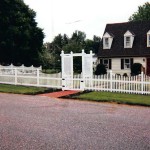Curb appeal is all about first impressions, whether you’re trying to impress prospective buyers or put a smile on your own face whenever you pull up to your house. A bright fence draws a buyer’s eye and makes your home more appealing. An easy way to add curb appeal to a home is by lining the front with a functional but decorative fence. Beautifully crafted fences are great for keeping out unwanted visitors while keeping children in without hiding the house. A well-chosen fence adds character to your home, along with a sense of security. There’s a reason we all cite the “white picket fence” as the ideal, it adds depth and encloses the yard but also draws the attention of a passersby with its clean lines and classic style. Other styles of fencing are equally attractive depending on the style of the home. Front yard fencing in the form of stone, wrought iron, or a wooden all accomplish the same delineation of property lines and offer a place to anchor shrubs or grow trellising vines.
Everyone has heard about the dream of a home with an iconic white picket fence. Somewhere embedded deep in the psyche of the average home buyer is that image of a beautiful house with a picket fence framing the yard. Tapping into that sub-conscious thought is an open doorway to instant curb appeal. Picket fences may be traditionally white or natural wood, averaging between 2 and 4 feet high. However, a simple change of color might make a more lasting impression on potential buyers. Matching the color of the picket fence to the trim color of your house gives a more visually uniform appearance while implying a certain neatness about the landscaping.
Ornamental iron fences add a certain elegance to even the most modest of homes. Ornamental iron fences have been used for centuries by the elite and eccentric. Ornamental iron fences add an air of mystery to the property. Neighborhoods that are steeped in historic heritage often welcome wrought iron fences in traditional black, but for neighbors who are not so mysterious an ornamental iron fence can be painted any color. Houses that have a fair amount of greenery around them benefit from a rich green wrought iron fence that blends well into the landscape but stands out enough to make a statement. Selecting a an ornamental iron fence and its color palette and scroll work should be done with the utmost consideration to keep the house feeling like a home and not like a prison.
Split rail fencing gives a home a very country feel. There is an openness about split rails that cannot be found in any other form of fencing. Split rails offer a definitive frame for a home and yard with minimal materials and require the least amount of maintenance. For instance, if a rail is damaged, only that single rail needs replacing, whereas in other fences whole sections may need replacing. This type of fencing lends itself to extreme versatility in the variety of different woods that can be used, the decision to paint the fence or not and the ability to add vines and plant life or leave in its natural state.
